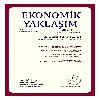Kriz ve para politikaları: Para politikalarının başarısızlığı üzerine
The 2007 financial and monetary policies: On the monetary policies's failure
___
- ANGERIZ Alvaro & ARESTIS Philip (2009), "The Consensus View on Interest Rates and Fiscal Policy: Reality or Innocent Fraud?", Journal of Post Keynesian Economics, Summer, C.31, S. 4, ss:567-586.
- APAK Sudi ve AYTAÇ Ayhan (2009), Küresel Krizler (Kronolojik Değerlendirme ve Analiz), İstanbul: Avcıol Basım Yayın.
- ARESTIS Philip & SAWYER Malcolm (2003) "Inflation Targeting: A Critical Appraisal", Levy Economics Institute of Board Collage Working Paper, No:388, http://www.lew.org (Erişim Tarihi: 15.01.2010).
- ARESTIS Philip, KARAKITSOS Elias (2009), "What Role For Central Banks in View of The Current Crisis?", The Levy Economics Institute of Bard Collage, Policy Note, No:2009/2. http://www.lew.org (Erişim Tarihi: 16.01.2010).
- BAYNE Nicholas (2008), "Financial Diplomacy And The Credit Crunch: The Rise of Central Banks", Journal of International Affairs, C. 62, S. 1, ss:l-16.
- BLANCHARD Olivier, DELL' ARICCIA Giovanni and MAURO Paolo (2010), "Rethinking Macroeconomic Policy", IMF Staff Position Note, Vol: 10, No:3, www.imf.org (Erişim Tarihi: 02.25.2010). ss:l-19.
- BORIO Claudio & LOWE Philip (2002), "Asset Prices, Financial and Monetary Stability: Exploring the Nexus", BIS Working Papers, No: 114. www.bis.org (Erişim Tarihi: 22.12.2009). ss:l-47.
- GOODHART C.A.E (2008), "The Backgraund to the 2007 Crisis", International Economics and Economic Policy, C. 4, S. 4, ss.331-346.
- ISSING Otmar (Winter 2009), "Asset Prices and Monetary Policy",Cato Journal, C. 29, S. 1, ss: 45-51.
- KROHN Gregory A. & GRUVER William R. (2008), "The Complexities of the Financial Turmoil of 2007 and 2008", Journal of Applied Business and Economics, C. 16, S. 1, (Erişim Tarihi: 01.02.2010). ss:l-28.
- LACKER Jeffrey M. (2009), "What Lessons Can We Learn From The Boom and Turmoil?", Cato Journal, C. 29, S. 1, ss.53-63.
- NEAL Penny (2008), "The Subprime Mortgage Crisis: Lessons For Regulators", Policy, C. 24, S. 2, ss: 19-25.
- PALLEY Thomas I. (2002), "The E-Money Revolution: Challanges and Implications for Monetary Policy", Journal of Post Keynesian Economics, C. 24, S. 2, ss:217-234.
- ROCHON Louis - Philippe and Mario Seccareccia (2008), "A Note on Deficits and Functional Finance Expenditures", http://www.progressive-economics.ca/2008/ll/25/defıcits-and-functional-fmance/ (Erişim Tarihi: 10.03.2010).
- SARIDOGAN Ercan (2010), Mikroekonomi ve Makroekonomi Düzeyinde Küresel Rekabet Gücünü Etkileyen Faktörler ve Stratejiler, İstanbul Ticaret Odası Yayınları, Akademik Yayınlar, Yayın No: 2010-51.
- SAWYER Malcolm (2009), "Fiscal and Interest Rate Policies in The 'New Consensus' Framework: A Different Perpective", Journal of Post Keynesian Economics, C. 31, S. 4, ss:549-566.
- SOROS George (2009), Finansal Piyasalar İçin Yeni Paradigma, Çeviren: Coşkun Üçüncü, İstanbul: İnkılâp Yayınevi.
- WEBER A. A, LEMKE W. and WORMS A. (2008), "How Usefull Is The Concept of The Natural Real Rate of Interest for Monetary Policy", Cambridge Journal of Economics, C. 32, S. 1, ss:49-63.
- WIGNALL Adrian Blundell, ATKINSON Paul ve LEE Se Hoon (2008), "The Current Financial Crisis-Causes and Policy Issues", Financial Market Trends, OECD. www.oecd.org (Erişim Tarihi: 03.15.2010).
- DURMUŞ Yılmaz (2008), "Küresel Mali Kriz ve Türkiye Ekonomisine Etkileri: Nasıl Başladı, Hangi Aşamadayız?", Ankara: TCMB, www.tcmb.gov.tr' (Erişim Tarihi: 15.02.2010).
- Bank for International Settlements (1994), Macroeconomic and Monetary Policy Issues Raised by The Growth of Derivatives Markets. Hannoun Report, CGFS Publications. No: 4, http://www.bis.org/list/cgfs/tid_6/index.htm (Erişim Tarihi: 01.03.2010).
- Bank for International Settlements (2008), Monetary Policy in The Advanced Industriel Economies, 78. Annual Report, http://www.bis. org/publ/arpdf/ ar2008e.htm (Erişim Tarihi: 06.02.2010).
- Bank for International Settlements (2009), Policy Responses to The Crisis, 79. Annual Report, http://www.bis.org/publ/arpdf/ar2009e.htm (Erişim Tarihi: 06.02.2010).
- International Monetary Fund (2009), World Economic Outlook, ss.108-118.www.imf.org (Erişim Tarihi: 01.04.2010).
- ISSN: 1300-1868
- Yayın Aralığı: 3
- Yayıncı: Ekonomik Yaklaşım Derneği
Kriz ve para politikaları: Para politikalarının başarısızlığı üzerine
Dünya ve Türkiye - Gıda güvencesi durumu
İMKB'de işlem gören reel sektör işletmelerinde ssermaye yapısının belirleyicileri
H. Aydın OKUYAN, H. Mehmet TAŞÇI
Etkin ücret teorisi ve Türkiye imalat sanayii üzerine uygulama
